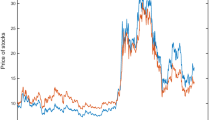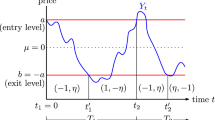Abstract
In this paper, we consider optimal pairs trading strategies in terms of static optimality and dynamic optimality under mean–variance criterion. The spread of the entity pairs is assumed to be mean-reverting and follows an Ornstein–Uhlenbeck process. A constrained optimal control problem is considered, and the Lagrange multiplier technique is adopted to transform the primal problem into a family of linear-quadratic optimal control problems that can be solved by the classical dynamic programming principle. Both solutions for static and dynamic optimal pairs trading problems are derived and discussed. We show that the “static and dynamic optimality” is a viable approach to the time-inconsistent control problem. Furthermore, numerical experiments are presented to demonstrate the performance of the optimal pairs trading strategies.










Similar content being viewed by others
Notes
In practice, the value of \(\gamma \) is important to the pairs trading strategies and can be determined by co-integration test. For more detailed discussion, we refer to [10]. If the two securities are stocks from the same financial sector (like two banking stocks), one may take this ratio to be unity.
References
Basak, S., Chabakauri, G.: Dynamic mean–variance asset allocation. Rev. Financ. Stud. 23(8), 2970–3016 (2010)
Bielecki, T.R., Jin, H., Pliska, S.R., Zhou, X.Y.: Continuous-time mean-variance portfolio selection with bankruptcy prohibition. Math. Financ. 15(2), 213–244 (2005)
Bollinger, J.: Using Bollinger bands. Stocks Commod. 10(2), 47–51 (1992)
Chiu, M.C., Wong, H.Y.: Mean-variance portfolio selection of cointegrated assets. J. Econ. Dyn. Control 35(8), 1369–1385 (2011)
Dai, M., Xu, Z.Q., Zhou, X.Y.: Continuous-time Markowitz’s model with transaction costs. SIAM J. Financ. Math. 1(1), 96–125 (2010)
Do, B., Faff, R., Hamza, K.: A new approach to modeling and estimation for pairs trading. In Proceedings of 2006 Financial Management Association European Conference, vol. 1, pp. 87–99 (2006)
Ekeland, I., Lazrak, A.: Being serious about non-commitment: subgame perfect equilibrium in continuous time. University of British Columbia, Preprint (2006)
Ekeland, I., Pirvu, T.: Investment and consumption without commitment. Math. Financ. Econ. 2(1), 57–86 (2008)
Elliott, R.J., Van Der Hoek, J., Malcom, W.P.: Pairs trading. Quant. Finance 5(3), 271–276 (2005)
Engle, R.F., Granger, C.W.: Co-integration and error correction: representation, estimation and testing. Econom. J. Econom. Soc. 55, 251–276 (1987)
Gatev, E., Goetzmann, W.N., Rouwenhorst, K.G.: Pairs trading: performance of a relative-value arbitrage rule. Rev. Financ. Stud. 19(3), 797–827 (2006)
Goldman, S.M.: Consistent plans. Rev. Econ. Stud. 47(3), 533–537 (1980)
Granger, C.W.: Some properties of time series data and their use in econometric model specification. J. Econom. 16(1), 121–130 (1981)
Huang, Y.: Inter-market pairs trading strategy construction using stochastic approach. Doctoral Dissertation, City University of Hong Kong (2014)
Huck, N.: Pairs selection and outranking: an application to the S &P 100 Index. Eur. J. Oper. Res. 196(2), 819–825 (2009)
Huck, N.: Pairs trading and outranking: the multi-step-ahead forecasting case. Eur. J. Oper. Res. 207(3), 1702–1716 (2010)
Krauss, C.: Statistical arbitrage pairs trading strategies: review and outlook. J. Econ. Surv. 31(2), 513–545 (2017)
Lim, A.E.: Quadratic hedging and mean–variance portfolio selection with random parameters in an incomplete market. Math. Oper. Res. 29(1), 132–161 (2004)
Liu, J., Timmermann, A.: Optimal convergence trade strategies. Rev. Financ. Stud. 26(4), 1048–1086 (2013)
Mackevičius, V.: Introduction to Stochastic Analysis: Integrals and Differential Equations. Wiley (2013)
Markowitz, H.: Portfolio selection. J. Finance 7(1), 77–91 (1952)
Mudchanatongsuk, S., Primbs, J.A., Wong, W.: Optimal pairs trading: a stochastic control approach. In: 2008 American Control Conference, pp. 1035–1039. IEEE (2008)
Nath, P.: High frequency pairs trading with US treasury securities: risks and rewards for hedge funds. Available at SSRN 565441 (2003)
Pedersen, J.L., Peskir, G.: Optimal mean–variance portfolio selection. Math. Financ. Econ. 11(2), 137–160 (2017)
Peleg, B., Yaari, M.E.: On the existence of a consistent course of action when tastes are changing. Rev. Econ. Stud. 40(3), 391–401 (1973)
Richardson, H.R.: A minimum variance result in continuous trading portfolio optimization. Manag. Sci. 35(9), 1045–1055 (1989)
Song, Q., Zhang, Q.: An optimal pairs-trading rule. Automatica 49(10), 3007–3014 (2013)
Strotz, R.H.: Myopia and inconsistency in dynamic utility maximization. Rev. Econ. Stud. 23(3), 165–180 (1955)
Selten, R.: Spieltheoretische Behandlung eines Oligopolmodells mit Nachfrageträgheit: Teil I: Bestimmung des dynamischen Preisgleichgewichts. J. Inst. Theor. Econ. 121(H.2), 301–324 (1965)
Tourin, A., Yan, R.: Dynamic pairs trading using the stochastic control approach. J. Econ. Dyn. Control 37(10), 1972–1981 (2013)
Vidyamurthy, G.: Pairs Trading: Quantitative Methods and Analysis. Wiley, New York (2004)
Whistler, M.: Trading Pairs: Capturing Profits and Hedging Risk with Statistical Arbitrage Strategies. Wiley, New York (2004)
Xia, J.: Mean-variance portfolio choice: quadratic partial hedging. Math. Financ. 15(3), 533–538 (2005)
Zhou, X.Y., Li, D.: Continuous-time mean-variance portfolio selection: a stochastic LQ framework. Appl. Math. Optim. 42(1), 19–33 (2000)
Zhu, D., Gu, J., Yu, F., Siu, T., Ching, W.K.: Optimal pairs trading with dynamic mean-variance objective. Math. Methods Oper. Res. 94(1), 145–168 (2021)
Acknowledgements
The authors would like to thank the two anonymous reviewers for their helpful comments and suggestions. This work was supported by the National Natural Science Foundation of China (No. 11671158, 11801262), the Research Grants Council of Hong Kong, GRF Grant (No. 17301522), the Gruangdong Basic and Applied Basic Research Foundation 2021A (No. 1515010031), Shenzhen Humanities and Social Sciences Key Research Bases, IMR and Seed Funding Research Grant, the University of Hong Kong.
Author information
Authors and Affiliations
Corresponding author
Additional information
Communicated by Klaus Reiner Schenk-Hoppe.
Publisher's Note
Springer Nature remains neutral with regard to jurisdictional claims in published maps and institutional affiliations.
Rights and permissions
Springer Nature or its licensor (e.g. a society or other partner) holds exclusive rights to this article under a publishing agreement with the author(s) or other rightsholder(s); author self-archiving of the accepted manuscript version of this article is solely governed by the terms of such publishing agreement and applicable law.
About this article
Cite this article
Yu, F., Ching, WK., Wu, C. et al. Optimal Pairs Trading Strategies: A Stochastic Mean–Variance Approach. J Optim Theory Appl 196, 36–55 (2023). https://doi.org/10.1007/s10957-022-02131-x
Received:
Accepted:
Published:
Issue Date:
DOI: https://doi.org/10.1007/s10957-022-02131-x




